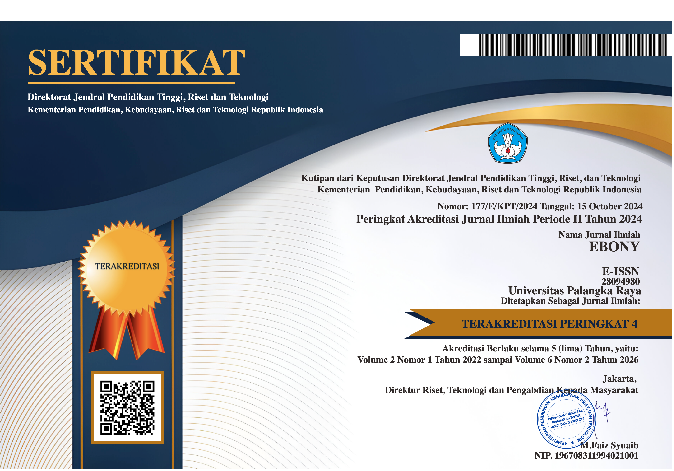An Analysis Types of Figurative Languages Used in The Sherlock Holmes; The Adventure of Sherlock Holmes of The Noble Bachelor
DOI:
https://doi.org/10.37304/ebony.v2i2.5282Keywords:
short story, figurative languages, meaningAbstract
The objectives of this research are to describe the types of figurative languages found in the short story, identify the meaning of the figurative languages, and find the most frequently used figurative language type in the story. The method used in this research is descriptive analysis. The data were collected from the adventure of noble bachelor short story. The research has found 41 figurative languages of 8 types, which are 21 metonymy (51.21%), 6 hipflask (14.63%), 4 epithet (9.76%), 3 synecdoche (7.32%), 2 metaphor 2 (4.88%), simile 2 (4.88%), irony 2 (4.88%), and innuendo (2.44%). The research has found that metonym used more than other figurative languages and the contextual meaning are used in the short story.
Downloads
References
Agung Yustina, I. G. N., Suardhana, I. W., & Lirishati Soethama, P. (2018). Figurative Language Used by Characters in the Sherlock Holmes 1 Movie Script “The Study in Pink.” Humanis, 22, 190. https://doi.org/10.24843/jh.2018.v22.i02.p27
Aprilianti, Y. (2020). An Analysis of Figurative Language in A Novel Entitled Heidi By Johanna Spyri.
Ardiansyah, N. M., & Mandarani, V. (2018). An Analysis of Figurative Language Elements upon an American Short Story Entitled “The Monkey’s Paw. JEES (Journal of English Educators Society), 3(1), 13-22.
Arman, S. D. (2016). An Analysis of Figurative Language In Eleven Stories By Leo Tolstoy. July, 1–23.
Deignan, A. (2015). Figurative language and lexicography. International Handbook of Modern Lexis and Lexicography, 1–15. https://doi.org/10.1007/978-3-642-45369-4_5-1
Saputri, E. E. W. (2014). An Analysis of figurative Languages Used in Rick Riordan’s Novel Entitled “The Heroes of Olympics, Book Three: The Mark of Athena”. Semarang: Dian Nuswantoro University.
Napitupulu, R., & Rusli, J. (2019). Transitivity System in Different Spoken Discourses. Journal of Language, Literature, and Teaching, 1(1), 42–55. https://doi.org/10.35529/jllte.v1i1.42-55
Nidya Pratiwi, M.R. Nababan, and D. (2017). Review of Figurative Language Based on Novel “Lady. October, 509–512. http://sastra.um.ac.id/wp-content/uploads/2017/11/509-513-Nidya-Pratiwi-et-al.pdf
Oktaviani, H. (2018). the Effectiveness of Using Short Stories on Faculty of Education and Teacher Training the State University for Islamic Studies Sultan.
Pertiwi, Y. R. (2019). Using Short Stories to Enhance Reading Ninth Grade Students of SMPN 06 Salatiga in The Academic Year of 2018/2019. Retrieved on December 1st, 2021 from https://etc.usf.edu/lit2go/32/the-adventures-of-sherlock-holmes/356/adventure-10-the-adventure-of-the-noble-bachelor/
Upreti, K. (2012). Teaching Short Stories: Challenges and Issues. A Thesis.
Downloads
Published
How to Cite
Issue
Section
License
Copyright (c) 2022 Talita Gabriel Adventalia, Susanty, Ristati

This work is licensed under a Creative Commons Attribution-NonCommercial 4.0 International License.











